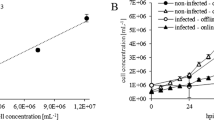Summary
A continuous culture of insect cells (Spodoptera frugiperda) was used for continuous production of baculovirus (nuclear polyhedrosis virus fromAutographa californica). The system consisted of a cascade of two continuous stirred tank reactors (CSTRs). In CSTR I the insect cells were grown in suspension. This suspension was fed continuously to CSTR II where the virus infection occurred. For a period of about 25 days the average volumetric productivity was about 107 polyhedra (virus particles occluded in protein capsules) and 108 infectious NOVs (non-occluded virus particles) per cm3 effluent. This is equivalent to 25 polyhedra and 250 NOVs per infected cell, respectively. In one case, the percentage of infected cells was 65%, which is close to the theoretical value of 68%. After a run-time of 32 days a decrease of process productivity was observed, probably due to the so-called passage effect, a degeneration of the virus DNA.
Similar content being viewed by others
References
De Gooijer, C.D., Van Lier, F.L.J., Van den End, E.J., Vlak, J.M. and Tramper, J. (1988). A model for baculovirus production with continuous insect-cell cultures. Submitted.
Faulkner, P. (1981). Baculoviruses. In:Pathogenesis of Invertebrate Microbial Diseases, E.A. Davidson, ed., pp. 3–37, Allanheld, Osmun & Co., Totowa, NJ.
Hink, W.F. (1970). Established insect cell line from the cabbage looper,Trichoplusia ni. Nature 226, 466–467.
Hink, W.F. (1982). Production ofAutographa californica nuclear polyhedrosis virus in cells from large-scale culture suspension cultures. In:Microbial and Viral Pesticides, E. Kurstak, ed., pp. 493–506, Marcel Dekker, Inc., New York.
Kelly, D.C. (1982). Baculovirus replication.J. Gen. Virol. 63 1–13.
Levenspiel, O. (1972).Chemical Reaction Engineering, pp. 253–296, J. Wiley & Sons., New York.
Luckow, V.A. and Summers, M.D. (1988). Trends in the development of baculovirus expression vectors.Bio/Technology 6, 47–55.
MacKinnon, E.A., Henderson, J.F., Stoltz, D.B., and Faulkener, P. (1974). Morphogenesis of nuclear polyhedrosis virus under conditions of prolonged passagein vitro.J. Ultrastr. Res. 49, 419–435.
Martignoni, M.E. (1984). Baculovirus: An attractive biological alternative. In:Chemical and Biological Controls in Forestry, W.Y. Garner and J. Harvey, eds., pp. 55–67, American Chemical Society.
Shapiro, M. (1986).In vivo productions of baculoviruses. In:The Biology of Baculoviruses, R.R. Granados and B.A. Federici, eds., vol. II, pp. 31–61, CRC Press, Inc., Boca Raton, FL.
Smith, G.E. and Summers, M.D. (1978). Analysis of baculovirus genomes with restriction endonucleases.Virology 89, 517–527.
Tramper, J. and Vlak, J.M. (1986). Some engineering and economic aspects of continuous cultivation of insect cells for the production of baculoviruses.Ann. N.Y. Acad. Sci. 469, 279–288.
Tramper, J., Williams, J.B. and Vlak, J.M. (1986). Shear sensitivity of insect cells.Enzyme Microb. Technol. 8, 33–36.
Vail, P.V., Jay, J.D. and Hink, W.F. (1973). Replication and infectivity of the nuclear polyhedrosis virus of the alfalfa looperAutographa californica, produced in cells grownin vitro.J. Invertebr. Pathol. 22, 231–237.
Van der Wikl, F, Van Lent, J.W.M. and Vlak, J.M. (1987). Immunogold detection of polyhedrin, plO and virion antigens inAutographa californica nuclear polyhedrosis virus-infectedSpodoptera frugiperda cells.J. Gen. Virology 68, 2615–2623.
Vaughn, J.L., Goodwin, R.H. and Tompkins, G.J. (1977). The establishment of two cell lines from the insectSpodoptera frugiperda (Lepidoptera: Noctuidae).In Vitro 13, 231–217.
Vlak, J.M. (1979). The proteins of non-occludedAutographa californica nuclear polyhedrosis virus produced in an established cell line ofSpodoptera frugiperda.J. Invertebr. Pathol. 34, 110–118.
Weiss, S.A., and Vaughn, J.L. (1986). Cell culture methodes for large-scale propagation of baculoviruses. In:The Biology of Baculoviruses, R.R. Granados and B.A. Federici, eds. vol II, pp. 63–87, CRC Press, Boca Raton, FL.
Author information
Authors and Affiliations
Rights and permissions
About this article
Cite this article
Kompier, R., Tramper, J. & Vlak, J.M. A continuous process for the production of baculovirus using insect-cell cultures. Biotechnol Lett 10, 849–854 (1988). https://doi.org/10.1007/BF01026994
Issue Date:
DOI: https://doi.org/10.1007/BF01026994




